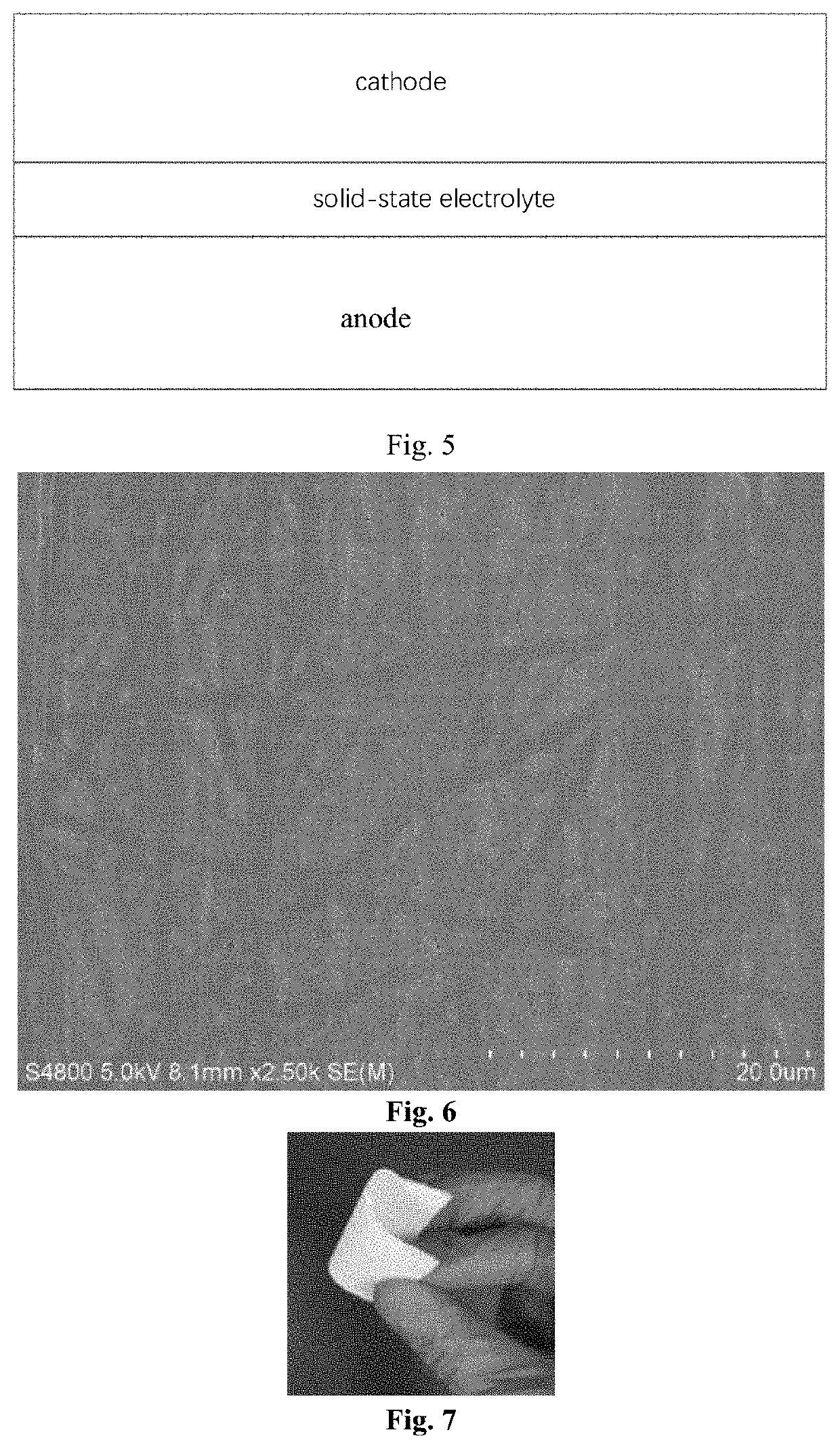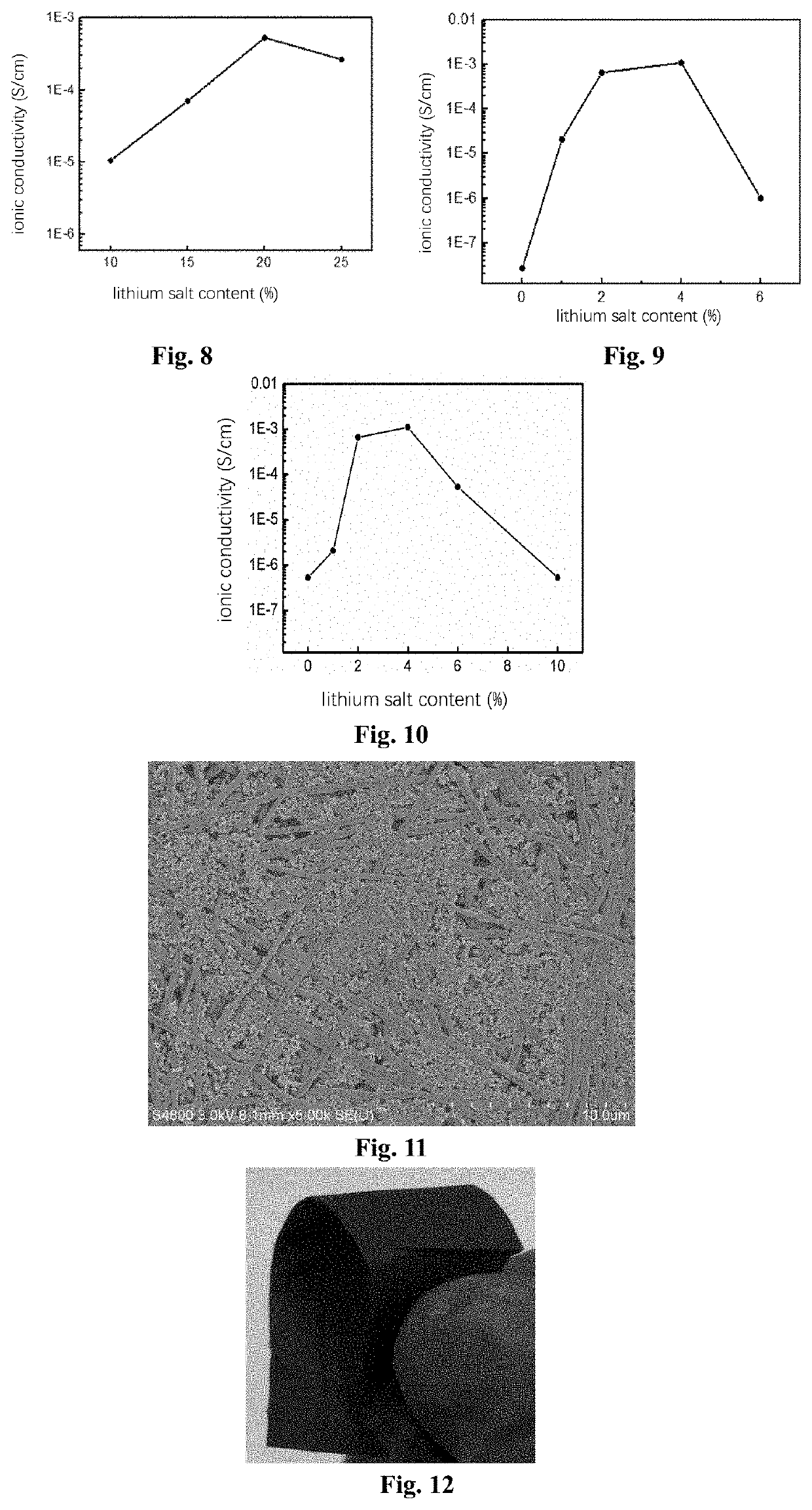Solid electrolyte, and preparation method therefor and application thereof
a solid electrolyte and electrolyte technology, applied in the field of electrochemicals, can solve the problems of battery energy density, fire and explosion hazards, fire or even explosion, etc., and achieve the effects of improving ionic conductivity, simple preparation, and rapid conduction of ions
- Summary
- Abstract
- Description
- Claims
- Application Information
AI Technical Summary
Benefits of technology
Problems solved by technology
Method used
Image
Examples
embodiment 1-1
[0283]About 1 g of commercially available polyacrylonitrile (PAN) powder was dissolved in 7 g of N,N-dimethylformamide (DMF) to obtain a polyacrylonitrile solution. Then, spinning was carried out at an electrostatic voltage of 15 KV, the distance between the sprayer and the drum receiving device was 15 cm, and the flow rate of the polyacrylonitrile solution was 15 μL / min, and after working in this way for about 5 hours, a flexible polymeric thin film was peeled off the drum receiving device, and then was rolled at about 2 MPa for about 10 minutes, then immersed in a 1 mol / L lithium perchlorate / ethanol solution for 5 minutes, and then vacuum dried to remove the solvent to obtain a sheet of solid-state electrolyte with a thickness of 20 μm and a polymer / lithium salt mass ratio of 2:1, and the density thereof was measured to be 1.9 g / cm3.
[0284]According to the calculation method of the specific interfacial area described above in the present disclosure, the specific interfacial area of...
embodiment 1-2
[0288]About 1 g of commercially available polymethyl methacrylate (PMMA) powder was dissolved in 9 g of DMF to obtain a polymethyl methacrylate solution. Then, spinning was carried out at an electrostatic voltage of 15 KV, the distance between the sprayer and the drum receiving device was 15 cm, and the flow rate of the polymethyl methacrylate solution was 15 μL / min, and after working in this way for about 7 hours, a flexible polymeric thin film was peeled off from the drum receiving device, and then was rolled at about 2 MPa for about 10 minutes, then immersed in a 1 mol / L lithium hexafluorophosphate / ethanol solution for 5 minutes, and then vacuum dried to remove the solvent to obtain a sheet of solid-state electrolyte with a thickness of 30 μm and a polymer / lithium salt mass ratio of 4:1, and the density thereof was measured to be 2.2 g / cm3.
[0289]According to the calculation method of the specific interfacial area described above in the present disclosure, the specific interfacial...
embodiment 1-3
[0290]About 1 g of commercially available polyvinylidene fluoride (PVDF) powder was dissolved in 9 g of N-methylpyrrolidone (NMP) to obtain a polyvinylidene fluoride solution. Then, spinning was carried out at an electrostatic voltage of 15 KV, the distance between the sprayer and the drum receiving device was 15 cm, and the flow rate of the polyvinylidene fluoride solution was 15 μL / min, and after working in this way for about 5 hours, a flexible polymeric thin film was peeled off the drum receiving device, and then was rolled at about 2 MPa for about 10 minutes, then immersed in a 1 mol / L lithium perchlorate / ethanol solution for 5 minutes, and then vacuum dried to remove the solvent to obtain a sheet of solid-state electrolyte with a thickness of 5 μm and a polymer / lithium salt mass ratio of 3:1, and the density thereof was measured to be 1.2 g / cm3.
[0291]According to the calculation method of the specific interfacial area described above in the present disclosure, the specific int...
PUM
| Property | Measurement | Unit |
|---|---|---|
| ionic conductivity | aaaaa | aaaaa |
| thickness | aaaaa | aaaaa |
| particle size | aaaaa | aaaaa |
Abstract
Description
Claims
Application Information
 Login to View More
Login to View More - R&D
- Intellectual Property
- Life Sciences
- Materials
- Tech Scout
- Unparalleled Data Quality
- Higher Quality Content
- 60% Fewer Hallucinations
Browse by: Latest US Patents, China's latest patents, Technical Efficacy Thesaurus, Application Domain, Technology Topic, Popular Technical Reports.
© 2025 PatSnap. All rights reserved.Legal|Privacy policy|Modern Slavery Act Transparency Statement|Sitemap|About US| Contact US: help@patsnap.com



